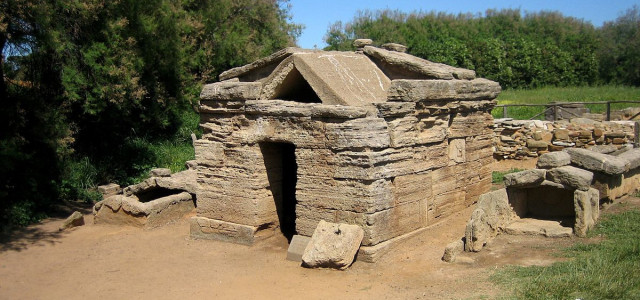Piombino
Piombino is an Italian town and comune of circa 35,000 inhabitants in the province of Livorno (Tuscany). It lies on the border between the Ligurian Sea and the Tyrrhenian Sea, in front of Elba Island and at the northern side of Maremma. Overview It has an ancient historical center, derived from the time in which it was the Etruscans' port, in the surroundings of Populonia. In the Middle Ages, it was instead an important port of the Republic of Pisa. Its hinterland hosts a considerable industrial area. Its port is still heavily used, both for industry and for tourism, with ferry-boats to Portoferraio (Elba) and Olbia (Sardinia). Geography The bounding communes of Piombino are Campiglia Marittima, Follonica, San Vincenzo and Suvereto. The town has 6 civil parishes (frazioni): Baratti, Fiorentina, Gagno, Populonia, Populonia Stazione and Vignale Riotorto. History The area of modern Piombino was settled since ancient times. During the Etruscan era the main city in the area was Populonia, now a frazione within the comune of Piombino. The name Piombino derives almost certainly from Populino, meaning "Small Populonia", which the refugees gave to a small village where they had taken refuge after the city had been attacked by Greek pirates (9th century CE). It is also probable that Piombino had already been founded during the Ostrogoth domination. In 1022 the Monastery of San Giustiniano was founded in the area, boosting the activity of fishers, sailors and workers. In 1115 Piombino submitted to the Republic of Pisa, becoming its second main port: authority was exerted by a Capitano ("Captain"). During the conflicts between the Pisane and the Genoese (12th-13th centuries) the city was sacked various times. In 1248 the Capitano Ugolino Arsopachi built the Channels. The Castle of Piombino remained a Pisane possession until Gerardo Appiani, ceding Pisa to the Milanese Visconti, carved out the independent state of Piombino, Elba, Pianosa and Montecristo for his family, who held it until 1634. In 1445, through his marriage with Caterina Appiani, Rinaldo Orsini acquired the lordship. In 1501-1503 the principality was under Cesare Borgia. In 1509 the Appiani became princes of the Holy Roman Empire with the title of Piombino. After Cosimo I de' Medici had occupied it in the course of the war against Siena, in 1553 and 1555 a French-Ottoman fleet attacked Piombino, but was pushed back. In 1557 the peace treaty reinstated the Appiani, with the exception of Portoferraio, given to the Grand Duchy of Tuscany, and the area of Orbetello, which became the State of Presidi under the Spanish control. In 1594 the Principality of Piombino was created by Emperor Rudolf II of Habsburg, the first prince being Alessandro Appiani d'Aragona. In 1634 the title was acquired by the Ludovisi, whose member Niccolò I had married Polissena Appiani in 1632. In 1708 it went to the Boncompagni with Antonio I. In 1801 Napoleon abolished the principate, Piombino and its lands being annexed to the Kingdom of Etruria; in 1809 they were given to Napoleon's sister, Elisa Baciocchi. After the Napoleon's final defeat and the congress of Vienna, the state of Piombino was annexed to the Grand Duchy of Tuscany. It became part of the unified Kingdom of Italy in 1860. During World War II, after the fall of the Fascist government, Piombino successfully resisted for some days an attempt of sea invasion by German forces. For the deeds of its citizens, the city received a Gold Medal for Military Valour by President Carlo Azeglio Ciampi. Main sights Co-Cathedral of Sant'Antimo (c. 1377), built by the Augustinians and originally dedicated to St. Michael. It is in Pisane-Gothic style, a memoir of the rule of Pisa over Piombino. The interior, with two naves (one added in 1933), houses precious works by Andrea Guardi, including a Baptismal Font. The counter-façade has Renaissance sepulchres of the Appiani family. Also by Guardi is the cloister (1470). The Rivellino (Walls Tower-Gate), the most ancient monument in the city (1212). The Chiesa della Misericordia (early 13th century). It houses a precious 15th century crucifix. The Cassero Pisano(Castle). It is formed by two distinct building, the Fortress, built under Cosimo I de' Medici (1552–53), and the Cassero (late 15th century), the latter used as military jail until 1959. The Palazzo Comunale (Town Hall), mostly a modern reconstruction of the ancient Palazzo degli Anziani (1435). In the Musters Hall, with portraits of the Princes of Piombino. Chapel of St. Anne, a noteworthy Renaissance work by Guardi. Annexed is the Torre Civica (Town Tower, 16th century). The Cisterna di Cittadella (Citadel's Cistern), also by Guardi. On the sides are the portraits of Jacopo III Appiani and his son and wife, later disfigured by order of Cesare Borgia. Casa delle Bifore (House of the Mullioned Windows, 1280s). The Natural Province Reserve Padule Orti Bottagone, created in 1998, next to the locality of Torre del Sale. Demographics Twin cities Flémalle (Belgium) Miscellanea Piombino has schools, gymnasia (middle school), lyceums (high school), churches, banks, parks and squares. In the locality of Punta Falcone is an astronomical observatory, created in 1976. East of Piombino, there is a power station with 1280 MW generation capacity with two chimneys, each 195 metres (640 ft) tall. West of Piombino, there is the start of the submarine power cable section to Corsica from HVDC SACOI. See also References External links (Italian) Official website of the Commune of Piombino (Italian) ANPI Piombino (Italian) Tourism in Piombino





